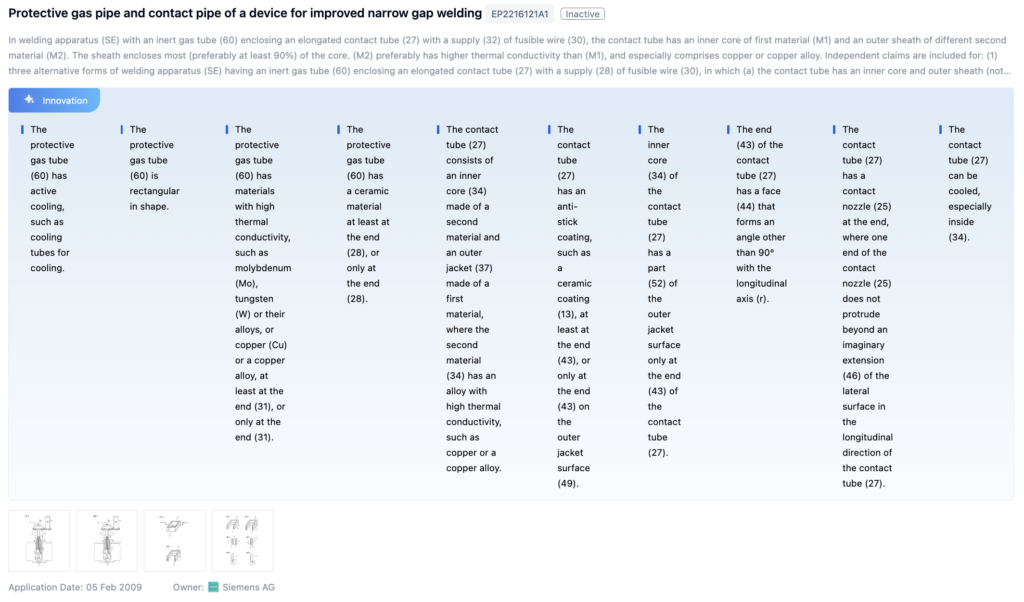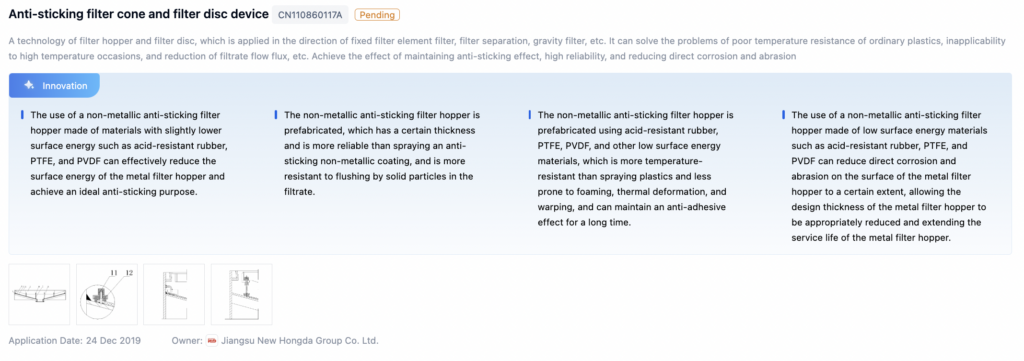
Technical Background and Objectives
Background
In the field of stick welding, improving the anti-stick welding performance of contact materials is crucial. Patent application data shows an initial increase in filings, reaching a peak, followed by a gradual decline. This trend suggests a period of significant innovation followed by maturation in the technology. The initial surge in patent applications likely resulted from breakthroughs or new discoveries that spurred research and development. As the technology matured, the rate of new inventions decreased, leading to fewer patent applications. The observed trends are based on patent data and may not capture the full scope of technological advancements.

Objectives
The primary objective is to investigate and develop innovative solutions to improve the anti-stick welding properties of contact materials used in stick welding processes. Enhancing these properties aims to mitigate sticking, thereby improving efficiency, quality, and reliability. Successful development of advanced materials could lead to significant cost savings, reduced rework, and increased productivity across multiple sectors.
To get a detailed scientific explanations of stick welding, try Eureka.
Technical Current Status Analysis
Stick Welding Overview
Stick welding, or shielded metal arc welding (SMAW), is used in various industries including construction, shipbuilding, and manufacturing. While offering versatility and portability, a major challenge is the occurrence of sticking or freezing of the electrode to the workpiece, leading to process disruptions and defects.
Applications and Impact:
- Construction: Welding of structural steel components, rebar, and metal structures.
- Shipbuilding: Fabrication and repair of ships and offshore structures.
- Manufacturing: Fabrication of machinery, equipment, and metal components.
Technical Characteristics and Challenges:
- Electrode Coating Composition: Optimization for fluidity and slag detachment to reduce sticking.
- Electrode Core Wire Composition: Adjustments to enhance weldability and minimize sticking.
- Arc Stability and Heat Transfer: Maintaining stability and optimizing heat transfer to prevent excessive heating and sticking.
- Slag Formation and Detachment: Enhancing properties for smooth welding and reduced sticking.
- Operator Skill and Technique: Proper techniques to minimize sticking.
- Environmental Factors: Controlling welding environment to reduce sticking issues.
Technological Paths:
- Optimized Electrode Coating Formulations: Advanced coatings for improved fluidity, slag detachment, and arc stability.
- Electrode Core Wire Development: Alternative compositions and manufacturing processes to enhance anti-stick performance.
- Advanced Electrode Design and Manufacturing: Innovative designs for better heat transfer, arc stability, and slag detachment.
- Welding Parameter Optimization: Identifying optimal parameters to minimize sticking.
- Welding Automation and Control Systems: Advanced systems for precise regulation of welding parameters and arc behavior.
- Operator Training and Skill Development: Comprehensive programs to enhance techniques and reduce sticking.
- Environmental Control and Surface Preparation: Measures to optimize the welding environment and ensure proper surface preparation.

Research Content
Research Objectives
Investigate and develop innovative solutions to improve the anti-stick welding properties of contact materials in stick welding processes, enhancing efficiency, quality, and reliability.
Research Direction and Focus
Material Composition and Characterization
- Analyze the composition and properties of existing contact materials.
- Characterize chemical, physical, and mechanical properties using techniques like X-ray diffraction, scanning electron microscopy, and energy-dispersive X-ray spectroscopy.
Novel Material Development
- Develop new materials with enhanced anti-stick properties.
- Modify chemical compositions, introduce additives or coatings, and employ advanced manufacturing techniques.
- Use computational modeling and simulations to guide material design.
Welding Process Optimization
- Optimize welding parameters such as current, voltage, travel speed, and shielding gas composition.
- Conduct experimental studies and statistical analysis to identify optimal conditions that minimize sticking.
Technical Development Roadmap
Key Areas of Advancement
- Consumable Electrode Technologies: Cellulosic coatings, flux-cored formulations, and alloyed materials for enhanced performance.
- Power Source and Arc Control Technologies: Inverter-based power supplies, arc stability techniques, and adaptive control systems.
- Automation and Monitoring Technologies: Robotic welding systems, weld quality monitoring, and augmented reality guidance.

Main Player Analysis
Key Players and Focus
- Dow Global Technologies LLC: Focus on advanced contact materials and coatings to minimize sticking.
- Nitto Denko Corp.: Comprehensive approach with advanced polymer compositions, ceramic coatings, and surface texturing.
- Daihen Corp.: Advanced materials, surface texturing, and innovative coating processes to improve weld quality and reduce sticking.
Current Technical Solution Overview
Welding Stick Composition and Coating
- Welding Stick Composition: Optimize chemical composition and add anti-stick coatings.
- Welding Stick Coating: Use specialized materials to facilitate smooth welding and reduce sticking.
- Contact Material Selection: Choose appropriate materials for electrode tips and backing to minimize adhesion.
- Process Optimization: Optimize heat input, travel speed, and shielding gas composition.
Welding Process Parameters and Techniques
- Parameter Optimization: Adjust heat input, control weld pool characteristics, and optimize sequences.
- Specialized Materials and Consumables: Develop materials with specific alloying elements and coatings.
- Joint Design and Preparation: Optimize joint geometry and surface treatment for better weldability.
- Monitoring and Control Systems: Advanced systems to detect and mitigate sticking issues.
Welding Contact Tip and Electrode Design
- Contact Tip Designs: Specific geometries, materials, and coatings to reduce sticking.
- Electrode Tip Materials and Coatings: Use ceramics or refractory metals with non-stick coatings.
- Cooling and Heat Management: Effective cooling strategies for contact tips.
Welding Joint Design and Preparation
- Joint Design: Specific geometries and configurations for improved weldability.
- Materials and Consumables: Specialized materials to reduce sticking.
- Preparation Techniques: Proper techniques for dissimilar materials.
- Fatigue Performance: Designs to improve fatigue life.
- Joint Protection: Backing and shielding techniques for joint protection.
Anti-Deformation and Anti-Corrosion Measures
- Anti-Deformation Devices: Devices to prevent distortion during welding.
- Anti-Corrosion Measures: Techniques and materials to protect welded joints.
- Welding Methods: Methods to minimize deformation.
Key Patent Interpretation
Patent Highlights
Patent 1: Anti-Sticking Device for Quartz Crystal Seal Welding
- Core Invention Points:
- Electromagnet assembly and anti-adhesive actuator to press down workpieces.
- Rotating arm and tension spring for proper alignment.

Patent 2: Protective Gas Pipe and Contact Pipe for Improved Narrow Gap Welding
- Core Invention Points:
- Protective gas tube with active cooling.
- High thermal conductivity materials for better performance.

Patent 3: Anti-Sticking Filter Cone and Filter Disc Device
- Core Invention Points:
- Non-metallic anti-sticking filter hopper made of low surface energy materials.
- Prefabricated hopper with acid-resistant materials for durability.

Possible Research Directions
- Welding Materials and Methods: Specialized wires, fluxes, and coatings to reduce sticking.
- Surface Modification Techniques: Chemical treatments, coatings, and surface texturing.
- Welding Contact Tip Designs: Designs to mitigate sticking during welding.
- Welding Joint Designs: Innovative joint designs for enhanced anti-stick performance.
If you want an in-depth research or a technical report, you can always get what you want in Eureka Technical Research. Try now!

